
Image courtesy of Scryfall.com
Randomness and Skill Meet My Undead Horde Awakens
In Magic: The Gathering, the dance between randomness and skill is a constant undercurrent, a rhythm that keeps games lively whether you’re piloting a doom-laden control deck or chasing the next big swing with a reanimator plan. The Oarc card My Undead Horde Awakens — an ongoing scheme from the Archenemy Schemes set — is a crisp case study in how a seemingly simple effect can tilt the balance between luck and strategy. 🧙♂️🔥 This single card embodies a tension we all feel at the table: you can try to predict outcomes, but the board demands adaptiveness, quick reads, and a willingness to ride the unpredictable rollercoaster of the game. ⚔️
What makes this scheme so engaging is its elegant constraint: “At the beginning of your end step, you may put target creature card from an opponent's graveyard onto the battlefield under your control. When a creature put onto the battlefield with this scheme dies, abandon this scheme.” No mana cost, no splashy mana ramp—just a precise, skill-intensive engine that can swing momentum in multiplayer chaos. The card’s art and flavor push it further into the mythos of undead armies waking with a calculated, almost ceremonial timing. The undead awaken not by pure luck, but by a player who reads the room, spots the best target in a graveyard, and seizes the moment before the scheme dissolves in a puff of death and retreat. 🎲🎨
The calculus of randomness: choosing the target creature
First, randomness enters the scene in the pool you’re allowed to pull from. The opponent’s graveyards are dynamic—creatures are blinking into and out of memory as sac outlets, removal, and combat remove and reclaim. The ability to select a target creature card from that graveyard is a skill check in disguise. The smarter you are about evaluating threats, synergies, and board-state tempo, the more value you extract. Do you reach for a game-ending behemoth that your opponents can’t answer quickly, or do you grab a utility creature that buys you crucial turns and lines up a lethal follow-up? The choice is yours, and the decision often hinges on the immediate risks: will this creature attract a kill spell in the next turn, or does it become a resilient engine that helps you stabilize through attrition? 🧙♂️
Then comes the secondary axis: the “death” trigger. When a creature reanimated by this scheme dies, the scheme ends. That constraint turns your big play into a temporary, but potent, spike in resources. It reframes how you plan your late-game: is the objective to build a temporary fortress of board presence, or to leverage a short-lived advantage into a longer, longer plan? The skill here is timing, sequencing, and risk management—knowing when to push, and when to pull back before your advantage evaporates. This is where randomness fades into the background and the strategist emerges. 💎
Design notes: why this feels like old-school magic in a modern frame
From a design perspective, Archenemy Schemes channels a classic “boss fight” energy into a multiplayer format. My Undead Horde Awakens embraces a simple mechanic with a big payoff and a plausible, high-stakes trade-off. The card’s text rewards planning and foresight, but it also keeps the door open for bold, improvisational plays. It’s not a flashy curve-topper with flashy mana costs; it’s a narrative engine: awaken, leverage, survive, and then—if you’re lucky—watch your undead horde topple back into the ether as the scheme is abandoned. This balance between persistent threat and volatile payoff mirrors the way good games feel: you’re always juggling what is certain, what is possible, and what you wish you could force to happen with a little more control. 🧙♂️⚔️
Collectors and nostalgia fans will also appreciate the card’s place in magic history. A common nonfoil from a distinctive “archenemy” set, it captures a quirky, era-defining moment in multiplayer play. The evocative name pairs with a streamlined mechanic that’s easy to teach but hard to master, making it a frequent pick for casual nights and quirky tournament mashups alike. And yes, the art by Thomas M. Baxa helps sell the mood—undead legions spilling into the frame with a quiet, inexorable inevitability. This is the kind of card that invites storytelling around the table as much as it invites counterplay. 🎨
Blending it with modern deck-building and clever tech
If you’re building around this scheme, you’ll want to consider synergy with graveyard interaction, reanimation payoffs, and ways to maximize value from the returned creatures before the inevitable drop-off. Cards that accelerate the end step, or that grant protection to the reanimated creatures long enough to turn a tide, can extend the playable window. Counterplay from opponents—removal, bounce, or graveyard hate—also shapes how the game unfolds. The thrill? You’re never guaranteed a win, but you’re constantly chasing a sequence of precise, satisfying decisions that feel earned rather than luck-driven. It’s the essence of skill meeting randomness in a friendly, chaotic dance. 🧙♂️🔥
For players who relish the tactile, story-forward experiences of MTG nights, this is the kind of card that sparks table talk and tall tales—an undead chorus rising on a carefully orchestrated beat. And for fans who want a modern physical anchor to their fandom, a tiny nod to real-world tech gear can feel oddly apt: just as a well-chosen creature returns to the battlefield at the right moment, your phone-shielded gear supports your long, good-humored grind of weekend battles. Speaking of gear, a rugged phone case can be a trusty companion on long nights of drafting, a reminder that even in magic as in life, the right protection helps you stay in the game. 🔥💎
Rugged Phone Case with TPU Shell Shock ProtectionMore from our network
- https://transparent-paper.shop/blog/post/distant-hot-giant-reveals-luminosity-through-temperature-and-radius/
- https://crypto-acolytes.xyz/blog/post/staking-yields-the-hidden-edge-for-day-traders/
- https://crypto-acolytes.xyz/blog/post/dota-2-vs-heroes-of-the-storm-which-moba-reigns/
- https://blog.digital-vault.xyz/blog/post/luminous-blue-giant-revealed-by-dr3-11800-light-years-away/
- https://transparent-paper.shop/blog/post/crowded-field-accuracy-for-a-hot-giant-star-at-two-kiloparsecs/